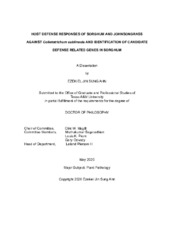| dc.description.abstract | While sorghum (Sorghum bicolor L. Moench.) is the fifth most important cereal grown worldwide, johnsongrass (Sorghum halepense L. Pers.) is a creeping perennial weed that interferes with crop productivity. Due to genetic similarity to sorghum, johnsongrass is considered to have potential as an alternate source of pathogen resistance genes for sorghum. In order to test this hypothesis, three isolates of Colletotrichum sublineola P. Henn., which causes sorghum anthracnose, were inoculated onto twenty-six johnsongrass cultivars collected from across the southern U.S. by using an excised leaf method. Each C. sublineola isolate caused various degrees of infection when inoculated onto different johnsongrass cultivars. Moreover, three different C. sublineola isolates caused different responses on the same johnsongrass cultivar. Expression of early defense response related genes, including β-1,3-glucanase, chalcone synthase 8 (CHS8), pathogen induced chitinase, flavonoid-3’-hydroxylase, pathogenesis related protein-10 (PR-10), and thaumatin-like protein, were measured 24 hrs and 48 hrs post inoculation in selected johnsongrass cultivars by Real-Time qRT-PCR. The results revealed that levels of defense responses varied among cultivars but were not sufficient to establish a basis for resistance. When the same johnsongrass cultivars were inoculated in a greenhouse study with conidia of C. sublineola isolate FSP53 from sorghum, some showed evidence of a hypersensitive response. However, successful reproduction of the pathogen as detected by formation of acervuli and setae was seen only on SH1116 and on only one leaf of this cultivar. In addition, C. sublineola isolates were inoculated on leaf blades and midribs of the johnsongrass cultivars along with two sorghum cultivars, BTx623 and SC748-5 by using an excised leaf method. Some johnsongrass cultivars and BTx623 showed different responses between the two tissues. Based on the results from Real-time qRT-PCR, host resistance gene expression in leaf blades and midribs showed three different patterns in BTx623 inoculated with FSP53 isolate of C. sublineola. Finally, a sorghum mini core collection was scored over several years for response to Colletotrichum sublineola, Peronosclerospora sorghi, and Sporisorium reilianum, the causal agents of anthracnose, downy mildew, and head smut, respectively. The screening results were combined with over 290,000 Single nucleotides polymorphic (SNP) loci from an updated version of a publicly available genotype by sequencing (GBS) dataset available for the mini core collection. GAPIT (Genome Association and Prediction Integrated Tool) R package was used to identify chromosomal locations that differ in disease response. When the top scoring SNPs were mapped to the most recent version of the published sorghum genome, in each case, a nearby and most often the closest annotated gene has precedence for a role in host defense. | en |


